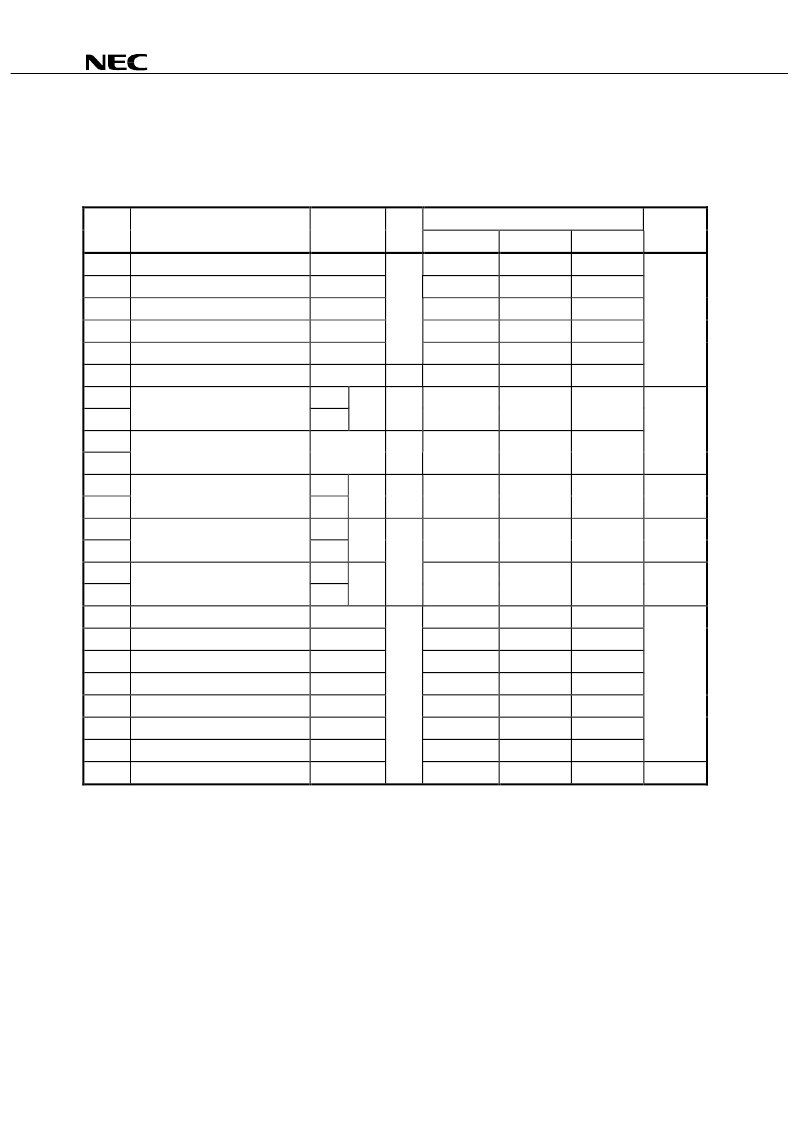- 您現(xiàn)在的位置:買賣IC網(wǎng) > PDF目錄384067 > μPD789198 (NEC Corp.) 8 Bit Single Chip Microcontrollers(8 位單片微控制器) PDF資料下載
參數(shù)資料
| 型號(hào): | μPD789198 |
| 廠商: | NEC Corp. |
| 英文描述: | 8 Bit Single Chip Microcontrollers(8 位單片微控制器) |
| 中文描述: | 8位單片機(jī)微控制器(8位單片微控制器) |
| 文件頁(yè)數(shù): | 20/146頁(yè) |
| 文件大小: | 630K |
| 代理商: | ΜPD789198 |
第1頁(yè)第2頁(yè)第3頁(yè)第4頁(yè)第5頁(yè)第6頁(yè)第7頁(yè)第8頁(yè)第9頁(yè)第10頁(yè)第11頁(yè)第12頁(yè)第13頁(yè)第14頁(yè)第15頁(yè)第16頁(yè)第17頁(yè)第18頁(yè)第19頁(yè)當(dāng)前第20頁(yè)第21頁(yè)第22頁(yè)第23頁(yè)第24頁(yè)第25頁(yè)第26頁(yè)第27頁(yè)第28頁(yè)第29頁(yè)第30頁(yè)第31頁(yè)第32頁(yè)第33頁(yè)第34頁(yè)第35頁(yè)第36頁(yè)第37頁(yè)第38頁(yè)第39頁(yè)第40頁(yè)第41頁(yè)第42頁(yè)第43頁(yè)第44頁(yè)第45頁(yè)第46頁(yè)第47頁(yè)第48頁(yè)第49頁(yè)第50頁(yè)第51頁(yè)第52頁(yè)第53頁(yè)第54頁(yè)第55頁(yè)第56頁(yè)第57頁(yè)第58頁(yè)第59頁(yè)第60頁(yè)第61頁(yè)第62頁(yè)第63頁(yè)第64頁(yè)第65頁(yè)第66頁(yè)第67頁(yè)第68頁(yè)第69頁(yè)第70頁(yè)第71頁(yè)第72頁(yè)第73頁(yè)第74頁(yè)第75頁(yè)第76頁(yè)第77頁(yè)第78頁(yè)第79頁(yè)第80頁(yè)第81頁(yè)第82頁(yè)第83頁(yè)第84頁(yè)第85頁(yè)第86頁(yè)第87頁(yè)第88頁(yè)第89頁(yè)第90頁(yè)第91頁(yè)第92頁(yè)第93頁(yè)第94頁(yè)第95頁(yè)第96頁(yè)第97頁(yè)第98頁(yè)第99頁(yè)第100頁(yè)第101頁(yè)第102頁(yè)第103頁(yè)第104頁(yè)第105頁(yè)第106頁(yè)第107頁(yè)第108頁(yè)第109頁(yè)第110頁(yè)第111頁(yè)第112頁(yè)第113頁(yè)第114頁(yè)第115頁(yè)第116頁(yè)第117頁(yè)第118頁(yè)第119頁(yè)第120頁(yè)第121頁(yè)第122頁(yè)第123頁(yè)第124頁(yè)第125頁(yè)第126頁(yè)第127頁(yè)第128頁(yè)第129頁(yè)第130頁(yè)第131頁(yè)第132頁(yè)第133頁(yè)第134頁(yè)第135頁(yè)第136頁(yè)第137頁(yè)第138頁(yè)第139頁(yè)第140頁(yè)第141頁(yè)第142頁(yè)第143頁(yè)第144頁(yè)第145頁(yè)第146頁(yè)

Preliminary Product Information
20
μ
PD789186, 789187, 789196, 789197
4.3.3
Special function registers (SFRs)
The SFRs are used as peripheral hardware mode registers and control registers. They are mapped in a 256-byte
space, from FF00H to FFFFH.
Table 4-1. Special Function Registers (1/3)
Address Special function register (SFR) name
Symbol
R/W
Number of bits manipulated simultaneously
When reset
1 bit
8 bits
16 bits
FF00H
Port 0
P0
R/W
{
{
00H
FF01H
Port 1
P1
{
{
FF02H
Port 2
P2
{
{
FF03H
port 3
P3
{
{
FF05H
Port 5
P5
{
{
FF06H
Port 6
P6
R
{
{
FF10H
MUL0L
R
{
{
Note 2
Undefined
FF11H
MUL0H
FF14H
A/D conversion result register 0
Note 3
ADCR0
R
{
Note 4
{
Note 5
FF15H
FF16H
16-bit compare register 90
CR90L
W
{
{
Notes 2, 6
FFFFH
FF17H
CR90H
FF18H
16-bit timer register 90
TM90L
R
{
{
Notes 2, 6
0000H
FF19H
TM90H
FF1AH
16-bit capture register 90
TCP90L
{
{
Notes 2, 6
Undefined
FF1BH
TCP90H
FF20H
Port mode register 0
PM0
R/W
{
{
FFH
FF21H
Port mode register 1
PM1
{
{
FF22H
Port mode register 2
PM2
{
{
FF23H
Port mode register 3
PM3
{
{
FF25H
Port mode register 5
PM5
{
{
FF32H
Pull-up resistor option register B2
PUB2
{
{
FF33H
Pull-up resistor option register B3
PUB3
{
{
FF42H
Timer clock selection register 2
TCL2
{
{
00H
Notes 1.
MUL0, CR90, TM90, and TCP90 are those SFR symbols used only in 16-bit access mode.
2.
16-bit access is allowed only with short direct addressing.
3.
When 8-bit A/D converters are used (for the
μ
PD789186 and
μ
PD789187), this register can be
accessed only in 8-bit mode. In this case, the address is assumed to be FF15H. When 10-bit A/D
converters are used (for the
μ
PD789196 and
μ
PD789197), this register can be accessed only in 16-bit
mode.
4.
This is supported only for the
μ
PD789186 and
μ
PD789187 (featuring 8-bit A/D converters).
5.
This is supported only for the
μ
PD789196 and
μ
PD789197 (featuring 10-bit A/D converters).
6.
CR90, TM90, and TCP90 are designed only for 16-bit access. With direct addressing, however, they
can also be accessed in 8-bit mode.
16-bit multiplication result storage
register 0
Note 1
MUL0
Note 1
CR90
Note 1
TM90
Note 1
TCP90
相關(guān)PDF資料 |
PDF描述 |
|---|---|
| μPD789216Y | 8 Bit Single Chip Microcontrollers(8 位單片微控制器) |
| μPD789217Y | 8 Bit Single Chip Microcontrollers(8 位單片微控制器) |
| μPD789405 | 8 Bit Single Chip Microcontrollers(8位單片微控制器) |
| μPD789407 | 8 Bit Single Chip Microcontrollers(8位單片微控制器) |
| μPD789406 | 8 Bit Single Chip Microcontrollers(8位單片微控制器) |
相關(guān)代理商/技術(shù)參數(shù) |
參數(shù)描述 |
|---|---|
| PD78F0134 | 制造商:NEC 制造商全稱:NEC 功能描述:8-Bit Single-Chip Microcontrollers |
| PD78F0134(A) | 制造商:NEC 制造商全稱:NEC 功能描述:8-Bit Single-Chip Microcontrollers |
| PD78F0134(A1) | 制造商:NEC 制造商全稱:NEC 功能描述:8-Bit Single-Chip Microcontrollers |
| PD78F0134A | 制造商:NEC 制造商全稱:NEC 功能描述:8-Bit Single-Chip Microcontrollers |
| PD78F0134A1 | 制造商:NEC 制造商全稱:NEC 功能描述:8-Bit Single-Chip Microcontrollers |
發(fā)布緊急采購(gòu),3分鐘左右您將得到回復(fù)。